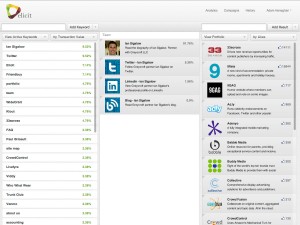Microsoft BizSpark startup uses Windows Azure to put keyword search control into the hands of humans rather than algorithms.
REDMOND, Wash. — April 3, 2013 — One of the biggest fears for website developers is that their visitors click an internal search button on the site, can’t find what they’re looking for and leave frustrated. Because every failed search can mean a lost opportunity for business owners, elicit was founded to help people find what they are looking for within a website.
The founders of elicit are all serial entrepreneurs who met when working together at various startups. Brothers Eric and Adam Heneghan are the co-founders of Giant Step, a digital marketing firm; Jeff Froom is an application and interaction developer; and Chip Aubry is a software architecture expert. While working at an interactive marketing agency, they formed the idea for elicit based on feedback from customers.
A client in the window manufacturing industry offered an extensive range of sizes, materials and other options in its products. The company’s website had poor search functionality, which made it difficult for customers to find the exact products they wanted. The idea stuck with the teammates, and they realized it would be helpful for their client to have control over its website’s search functionality.
“We knew that site search was a universal problem that was crying out to be fixed,” said Aubry, co-founder and vice president of Architecture at elicit. “But with our agency backgrounds, we also recognized that we couldn’t build a sustainable business by offering one-off solutions. We launched elicit in 2011 to make a site-search solution available to marketers at any website in the world, and we chose a software-as-a-service (SaaS) model because it made sound business sense.”

Conference Call. A drag-and drop-interface lets the customer prioritize and target results by context, time, keyword, location or any way they need. Image credit: Microsoft
A Contrarian Approach: Less Automation, More Human Touch
To develop a solution, elicit approached the problem with the understanding that searching an individual website is a vastly different experience than broadly searching the Internet.
“People use ‘browse’ and ‘search’ in entirely different ways when they’re looking for information,” said Aubry. “The algorithmic-based approach of search engines that’s appropriate when sifting through the entire Internet universe is not well suited to finding what you need within a particular website.”
The team researched how website visitors actually behave when they’re trying to find something on a site.
“We found that when using elicit on a website, 50 keywords and associated synonyms represent approximately 50 percent of the searches on that site,” said Aubry. At that scale, it’s easier to put keyword search control into the hands of humans rather than algorithms.

elicit Screenshot. With elicit’s solution, marketers can determine the most effective keywords for their website. Image credit: Microsoft (Click image to enlarge)
The elicit solution lets marketers paste a simple JavaScript analytics tag directly onto their websites, then determine the most effective keywords for their site and prime them into the system using a simple drag-and-drop interface.
Keywords can be changed as often as needed to take advantage of new products, promotions, marketing campaigns or evolutions in customer search behavior. elicit search is also designed to work on social media sites and mobile devices as well as on any website.
“We’re challenging the point of view that says site search needs to be primarily automated,” said Aubry. “By emphasizing human curation over algorithms, elicit search decreases SEO-generated noise in search results, allows for fine-tuning and control of search results and descriptions, and vastly improves the effectiveness for both customers and marketers.”
The Confidence to Take Risks
The team works with marketers and retailers to make site search a powerful tool. Early adopters of elicit are reporting that their click-through rates doubled and abandonment rates dropped by half.
Still, every startup faces risks, even for veterans of the entrepreneurial ecosystem.
“We wouldn’t have been able to create what we did without the support of the Microsoft BizSpark program and Windows Azure technology,” Aubry said. “BizSpark allowed us to take risks in pursuing our contrarian approach without having to worry about overspending at the beginning of our venture.”
The elicit founders also chose Windows Azure SQL Database to manage the application data because it worked well with their existing ASP.NET and Visual Studio 2012 technologies and could help them scale to meet the demands of their clients’ high-traffic websites.
“Windows Azure takes care of things such as provisioning the virtual machines, firewalls, load balancing and redundancy, so we can focus on building our application and making it great,” said Aubry.
elicit also takes advantage of the SaaS model to implement frequent improvements to its search solution. The team consistently talks to its customers to gain valuable feedback about how it can make elicit search even better.
“As soon as we come up with a new feature or a performance improvement, the SaaS approach lets us push it out immediately to our customers,” Aubry said. “More often than not, though, our customers report that they are delighted to have such a simple and powerful way to control their site search.”
*Source: Microsoft
